
Table of Contents
1. Introduction
Brief on the Importance of Storytelling and Writing
Stories weave through our lives, binding us with threads of emotions and experiences. They take us on journeys, exploring worlds and characters that linger in our minds. In this post, we’ll explore various example of stories, each one a unique journey into different realms of fiction and storytelling.
Various Story Examples Explored in the Post
From short fiction stories to succinct narratives, we’ll dive into different examples of short story, analyzing their elements and understanding the craft of storytelling. Whether you’re a reader seeking your next favorite tale or a writer looking for inspiration, read further this literary adventure.
2. The Essence of a Great Short Story
Defining What Makes a Story Captivating- Following are a few points that make the story engaging and captivating-
a. Engaging Plot
What is the plot of a story
The answer is simple- The plot is like the main road of a story. It shows us what happens, how characters solve problems, and how the story ends. It’s the big adventure or problem that makes us want to read more!
Plot Includes a clear beginning, middle, and end, with conflicts and resolutions.
b. Relatable or Real Looking Characters
Imagine reading a story where you see a bit of yourself in the characters. It’s like looking into a mirror, isn’t it? Relatable or real-looking characters make stories feel close to our hearts because they act like we would, feel like we do, and even talk like us sometimes.
c. Utilizing Descriptive Language that Appeals to the Senses
Imagine biting into a juicy apple. Can you taste the sweetness and feel the crunch? That’s the power of descriptive language! When writers use words that tickle our senses – sight, hearing, touch, taste, and smell – they paint vivid pictures in our minds and make stories come alive.
d. Emotional Resonance
A story that triggers emotional responses, whether it’s joy, sorrow, fear, or excitement.
Themes and narratives that readers can connect with on an emotional level.
e. Conflict and Resolution
Presenting conflicts that are intriguing and resolutions that are satisfying. Ensuring that conflicts are resolved in a manner that is consistent with the story and characters.
f. Satisfying Conclusion
Providing a conclusion that ties up loose ends and leaves the reader satisfied. Ensuring the ending is consistent with the preceding narrative and character arcs.
Each of these points plays a crucial role in making a story captivating and memorable for readers.
3. Diving into Short Fiction: Examples and Analysis
Also Read:
- Story Writing Class 9 & 10 (Tips, Examples & Worksheets)
- Story Writing Class 8 (Tips, Examples & Worksheets)
- Story Writing Techniques and Solved Examples
- Story Writing Techniques and Solved Examples
1. Example of Story : “The Tale of Peter Rabbit” by Beatrix Potter
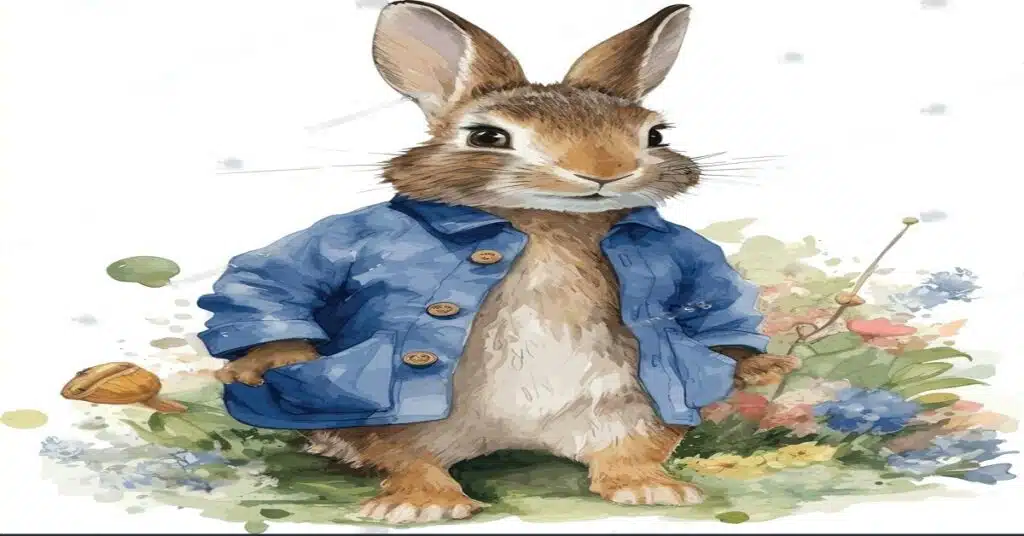
1- Brief of the Story- The Tale of Peter Rabbit
“The Tale of Peter Rabbit” introduces us to a cheeky and disobedient rabbit named Peter, who sneaks into Mr. McGregor’s garden despite his mother’s warnings. In the garden, he munches on various vegetables but soon faces the consequences as Mr. McGregor spots him.
A chaotic chase ensues, with Peter experiencing close shaves and eventually losing his clothes in the process. After several narrow escapes, Peter manages to return home, exhausted and ill, only to be put to bed by his mother while his obedient sisters enjoy a delicious supper.
2- Title Analysis of The Tale of Peter Rabbit
The title, “The Tale of Peter Rabbit,” is straightforward yet endearing, immediately introducing the central character and hinting at a story centered around him. It’s catchy in its simplicity and directness, ensuring it appeals to the target audience of children and their parents by promising a tale about the adventures of a little rabbit named Peter.
3- Analyzing Key Elements and Takeaways
The story is a delightful yet cautionary tale that intertwines adventure with moral lessons. Beatrix Potter masterfully uses simple language, engaging dialogues, and beautiful illustrations to bring the story to life, ensuring it is accessible and enchanting for young readers while also holding subtle warnings about the consequences of disobedience and the importance of listening to parental advice.
4- Character Names of the story : The Tale of Peter Rabbit
Peter Rabbit, Mr. McGregor, Mrs. Rabbit, Flopsy, Mopsy, and Cottontail.
5- Plot Points: Peter’s disobedience in going to the garden, the thrilling chase with Mr. McGregor, and the contrasting fates of the obedient and disobedient siblings.
6- Themes of the Story
– Disobedience and Consequence: Peter’s adventures underscore the perils that can arise from not heeding warnings and choosing to act rebelliously.
– Adventure and Escapade: Despite the moral undertones, the story doesn’t shy away from showcasing the thrill and excitement of Peter’s forbidden escapade.
– Parental Guidance and Safety: The contrasting outcomes for Peter and his sisters highlight the safety found in heeding parental guidance.
– Cleverness and Escape: Peter’s various clever tactics to escape Mr. McGregor’s clutches add an element of wit and intelligence to his character, despite his initial disobedience.
“The Tale of Peter Rabbit” remains a cherished tale across generations, blending adventure, moral lessons, and the timeless charm of its furry protagonist.
Example 2: “The Night Before Christmas” by Clement Clarke Moore
1- Brief of the Story
“The Night Before Christmas,” also known as “A Visit from St. Nicholas,” unfolds on a serene Christmas Eve, where a father, stirred by a clatter outside, witnesses the enchanting arrival of St. Nicholas, more commonly known as Santa Claus. With his lively team of reindeer and a sleigh brimming with gifts, Santa descends the chimney and, with a twinkle in his eye, swiftly goes about his work, placing presents for the awaiting children. The father observes in silent awe, and with a swift nod, Santa departs, wishing all a “Happy Christmas” before vanishing into the tranquil night.

2- Title Analysis
“The Night Before Christmas” is a title that instantly evokes a sense of anticipation and festivity. It’s a simple yet evocative title, conjuring images of the excitement and magic that pervades the hours leading up to Christmas. The title is both inviting and nostalgic, resonating with the universal eagerness experienced on Christmas Eve and promising a tale that is both cozy and enchanting.
3- Analyzing Key Elements and Takeaways
The story, with its rhythmic prose and vivid imagery, encapsulates the magic and wonder of Christmas through the eyes of a surprised parent. Moore crafts a narrative that is both whimsical and heartwarming, utilizing a blend of imaginative descriptions and a rhythmic cadence to transport readers into the enchanting world of festive mystery and benevolent intruders, thereby creating a timeless piece that has become synonymous with the Christmas spirit.
4- Character Names
– The Narrator (the father)
– St. Nicholas (Santa Claus)
– Dasher, Dancer, Prancer, Vixen, Comet, Cupid, Donder, and Blitzen (the reindeer)
5- Plot Points
– The father’s curiosity piqued by a sudden noise.
– The unexpected, magical appearance of Santa Claus and his reindeer.
– The silent, swift, and efficient delivery of Christmas gifts.
– Santa’s cheerful departure, leaving behind joy and presents.
6- Themes of the Story
– Magic and Wonder: The unexpected visit from Santa Claus, the reindeer, and the magical departure encapsulate the mystical elements of the Christmas season.
– Anticipation and Excitement: The setting on Christmas Eve and the arrival of gifts highlight the eager anticipation of the festive day.
– Joy and Generosity: Santa’s jovial demeanor and the act of gift-giving underscore themes of joy and selfless giving that define the holiday spirit.
– Belief and Imagination: The seamless blend of the ordinary and the extraordinary invites readers to immerse themselves in the boundless possibilities of belief and imagination.
“The Night Before Christmas” continues to be a beloved story that encapsulates the essence and magic of Christmas, offering a glimpse into a world where benevolent figures bestow gifts and joy in the quietude of a wintry night.
Example 3: “Little Red Riding Hood” by Charles Perrault
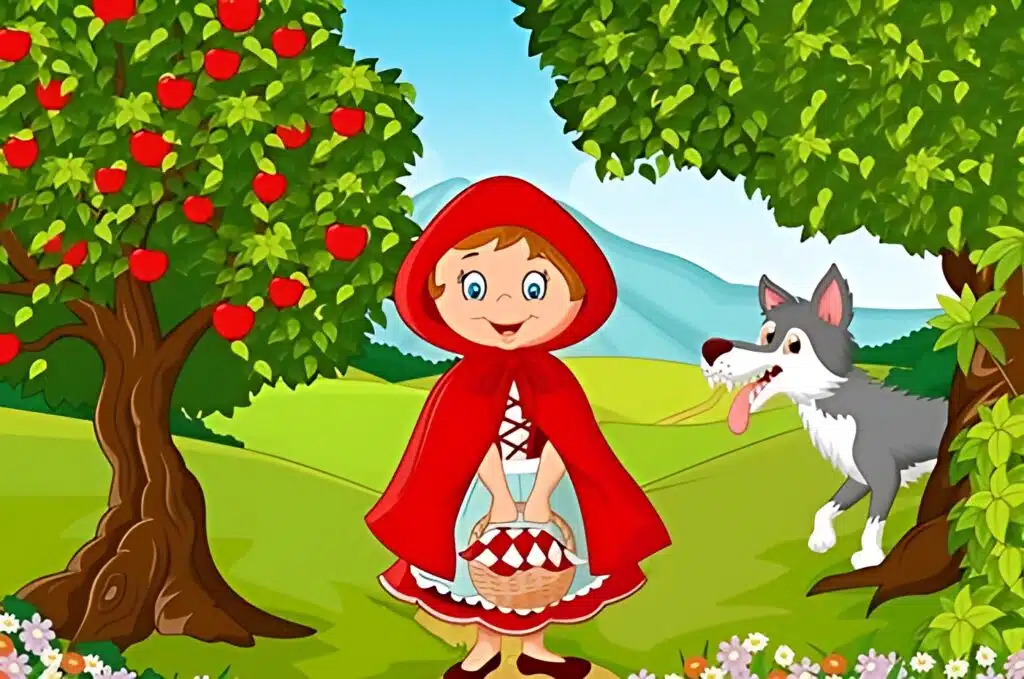
1- Brief of the Story
“Little Red Riding Hood” spins a simple yet profound tale of a sweet little girl, known for her striking red hooded cloak, who sets off through the woods to visit her ailing grandmother. Her mother warns her to stay on the path and be wary of strangers. However, the naive girl encounters a sly wolf, sharing her destination with him. The wolf, seizing the opportunity, races ahead, devours her grandmother, and cunningly takes her place, ultimately tricking Little Red Riding Hood upon her arrival, leading to a dark and unexpected conclusion.
2- Title Analysis of “Little Red Riding Hood”
The title “Little Red Riding Hood” is straightforward and memorable, highlighting the protagonist’s signature attire, which plays a pivotal role in the story. It’s catchy and instantly recognizable, providing a clear image of the main character and setting the stage for a tale that intertwines innocence with dark undertones. The simplicity of the title makes it accessible and appealing to a young audience while also intriguing enough to captivate readers of all ages.
3- Analyzing Key Elements and Takeaways
This classic example of a short story intertwines innocence with a stark warning about the dangers of naivety and disobedience. The straightforward narrative, clear characters, and the unexpected dark twist at the end provide a stark moral lesson about the perils of straying from the advised path and the potential consequences of trusting strangers, making it a timeless tale that transcends generations.
4- Character Names
– Little Red Riding Hood
– The Wolf
– Grandmother
– Mother
5- Plot Points
– Little Red Riding Hood is tasked to deliver goods to her sick grandmother.
– She encounters the wolf and naively reveals her destination.
– The wolf deceives and devours the grandmother, then disguises himself as her.
– Little Red Riding Hood arrives and is ultimately deceived and consumed by the wolf.
6- Themes of the Story
– Innocence and Naivety: Little Red Riding Hood’s innocence is contrasted starkly with the cunning malevolence of the wolf.
– Obedience and Disobedience: The tragic outcome serves as a potent reminder of the potential dangers that can arise from disregarding parental advice.
– Deception and Trust: The wolf’s deception and the misplaced trust of Little Red Riding Hood explore the perils of trusting appearances and strangers.
– Safety and Danger: The safe path and the dangerous wolf symbolize the constant juxtaposition between safety and danger in the journey of life.
“Little Red Riding Hood” remains a poignant example of a story that, through its simple narrative and clear moral lesson, continues to serve as a cautionary tale about obedience and the potential dangers that can arise from naivety and misplaced trust.
Example 4: “Hansel and Gretel” by the Brothers Grimm
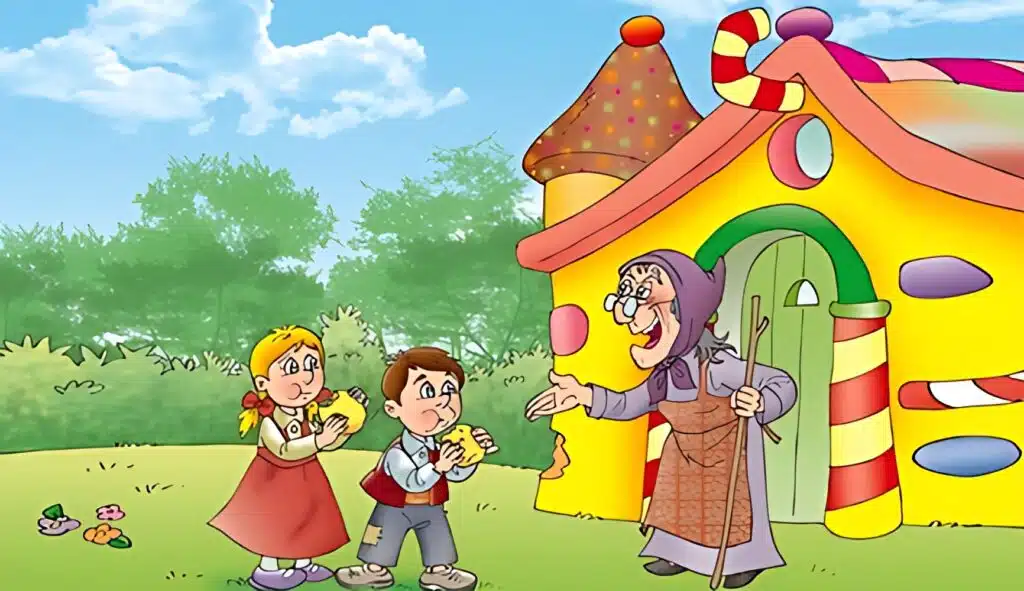
1- Brief of the Story
“Hansel and Gretel” is a captivating tale about two siblings who find themselves abandoned in a dense forest by their struggling parents. The clever brother and sister, Hansel and Gretel, embark on a perilous adventure, stumbling upon a house made of sweets, which is a trap set by a wicked witch. The witch, intending to devour them, is outsmarted by the brave and quick-thinking children. In a daring escape, they manage to push the witch into her own oven and find their way back home, reuniting with their remorseful father and living happily with the treasures they found.
2- Title Analysis
The title “Hansel and Gretel” is simple, direct, and effortlessly draws attention to the main characters, providing a clear indication that the story will revolve around the adventures or misadventures of these two children. It’s an unembellished title that has become synonymous with themes of bravery, resourcefulness, and the classic struggle between good and evil, making it a timeless example of story that appeals to both young and adult readers alike.
3- Analyzing Key Elements and Takeaways
The story, while being an enchanting example of short story writing, intertwines dark themes with triumphant victory, showcasing the children’s bravery, wit, and the ultimate triumph over the malevolent witch. It serves as a narrative that explores both the dark and light aspects of human nature and circumstances, providing a rich, multifaceted tale that has been retold in various forms across generations.
4- Character Names
– Hansel
– Gretel
– The Witch
– Father
– Stepmother
5- Plot Points of the story – Hansel and Gretel
– Hansel and Gretel are abandoned in the forest due to their family’s poverty.
– They discover a house made of sweets, only to find it’s a trap set by a cannibalistic witch.
– The siblings outsmart the witch, leading to her demise, and find treasures that ensure their prosperous future.
– They return home, forgiving their father, and live happily thereafter.
6- Themes of the Story
– Bravery and Resourcefulness: Hansel and Gretel showcase immense bravery and clever tactics to overcome the dire situations they face.
– Betrayal and Redemption: The abandonment by their parents and the subsequent reunion explores themes of betrayal and redemption.
– Greed and Consequence: Both the witch’s and stepmother’s greed lead to their downfalls, providing a moral about the perils of avarice.
– Love and Forgiveness: Despite the hardships, the love between the siblings and their father prevails, showcasing the power of forgiveness and familial bonds.
“Hansel and Gretel” stands as a classic example of short story writing, where the simplicity of the narrative, the clear moral undertones, and the adventurous spirit of the characters weave a tale that has continued to captivate audiences with its dark allure and triumphant resolution.
Example 5: “The Boy Who Cried Wolf” by Aesop

1- Brief of the Story
“The Boy Who Cried Wolf” unfolds a simple yet impactful tale of a young shepherd boy tasked with safeguarding a flock of sheep. Bored and seeking attention, the boy falsely cries out that a wolf is attacking the flock, amusing himself by watching the villagers rush to his aid, only to find no wolf. He repeats this deceit until, when a real wolf appears and threatens the flock, his cries for help are dismissed as another trick, resulting in dire consequences for the sheep and a valuable lesson about the repercussions of dishonesty.
2- Title Analysis
The title “The Boy Who Cried Wolf” is straightforward and encapsulates the core premise of the story, providing a clear hint towards the narrative and its moral lesson. It’s a classic, unembellished title that immediately brings to mind the proverbial warning about the consequences of falsehood, making it a timeless and universally recognized example of story that transcends cultures and generations.
3- Analyzing Key Elements and Takeaways
Aesop crafts a narrative that, through its simplicity and clarity, delivers a potent message about the consequences of dishonesty and the loss of trust. The story, while brief, effectively utilizes the boy’s repeated deceit and the ultimate repercussions as a powerful metaphor for understanding the importance of honesty and the potential perils of losing credibility through falsehood.
4- Character Names
– The Boy (Shepherd)
– The Villagers
– The Wolf
5- Plot Points
– The boy, tasked with guarding the sheep, falsely cries wolf to garner attention.
– The villagers rush to his aid multiple times, only to find no threat.
– When a real wolf appears, the boy’s genuine cries are ignored, leading to a loss.
– The boy learns a valuable lesson about the consequences of dishonesty.
6- Themes of the Story
– Honesty and Dishonesty: The story underscores the value of honesty and the repercussions that arise from deceit.
– Trust and Credibility: The boy’s repeated lies erode the trust of the villagers, highlighting the fragility of credibility.
– Responsibility and Consequence: The boy’s neglect of his duty and misuse of trust result in tangible loss, illustrating the direct impact of irresponsibility.
– Wisdom and Foolishness: The boy’s initial amusement turns to regret, showcasing the short-sightedness of foolish actions and the wisdom in maintaining integrity.
“The Boy Who Cried Wolf” serves as a poignant example of a story that, through its clear narrative and moral lesson, continues to be relevant in teaching values of honesty and responsibility across various contexts and to successive generations.
Example 6: “The Tortoise and the Hare” by Aesop

1- Brief of the Story
“The Tortoise and the Hare” is a classic fable that tells the tale of a race between the slow-moving tortoise and the swift hare. The hare, overly confident in his speed, mocks the tortoise and is so certain of his win that he decides to take a nap mid-race. The tortoise, however, remains steadfast and continues to move forward, ultimately crossing the finish line before the hare awakens. The moral of the story emphasizes that slow and steady progress can be more effective than erratic speed, highlighting the values of persistence and humility.
2- Title Analysis
The title “The Tortoise and the Hare” is simple, clear, and directly introduces the main characters and the contrasting attributes that will be pivotal in the unfolding tale. It sets the stage for a narrative that will explore the juxtaposition between speed and steadiness, providing an easily recognizable and classic example of story that has been retold in various forms and mediums.
3- Analyzing Key Elements and Takeaways
Aesop’s fable, through its straightforward narrative and clear moral lesson, provides a timeless example of short story writing that explores the virtues of persistence, humility, and the potential pitfalls of overconfidence. The story, while simple, effectively conveys its message through the contrasting characteristics and outcomes of its characters, offering a universally relevant moral lesson.
4- Character Names
– The Tortoise
– The Hare
5- Plot Points
– The confident hare challenges the slow-moving tortoise to a race, mocking his slowness.
– Overconfident in his speed, the hare decides to take a nap during the race.
– The tortoise, undeterred and consistent, continues to move towards the goal.
– The hare awakens to find the tortoise nearing the finish line and despite his speed, cannot catch up, leading to the tortoise’s victory.
6- Themes of the Story
– Persistence and Consistency: The tortoise’s unwavering determination and consistent movement lead to his success.
– Overconfidence and Humility: The hare’s overconfidence leads to his downfall, while the tortoise’s humility and perseverance are rewarded.
– Effort and Complacency: The story highlights the importance of continuous effort and the risks of becoming complacent in one’s endeavors.
– Victory and Defeat: The unexpected outcome of the race illustrates that victory is not always determined by apparent advantages but by utilizing one’s strengths effectively.
“The Tortoise and the Hare” remains a beloved example of a story that, through its simplicity and clear moral, continues to teach valuable lessons about perseverance, humility, and the importance of never underestimating others, resonating with readers of all ages.
Example 7: “The Emperor’s New Clothes” by Hans Christian Andersen

1- Brief of the Story
“The Emperor’s New Clothes” unfolds as a humorous and insightful tale of a vain Emperor, obsessed with his appearance and wardrobe. Two cunning weavers capitalize on his vanity, promising him a set of unique, invisible clothes that can only be seen by the wise and competent. The Emperor, his ministers, and the townsfolk, unwilling to appear foolish, all pretend to see and admire the non-existent garments. It takes the innocent honesty of a child to proclaim that the Emperor is, in fact, parading in the nude, revealing the collective denial and pretense of the adults.
2- Title Analysis
The title “The Emperor’s New Clothes” is both straightforward and subtly ironic, presenting a seemingly simple story about royal attire while also hinting at deeper, underlying themes about vanity, deception, and societal denial. It’s a title that invites curiosity while also providing a clear entry point into the satirical and moral-laden narrative that Andersen masterfully weaves.
3- Analyzing Key Elements and Takeaways
Andersen crafts a story that, while whimsical and humorous on the surface, provides a sharp commentary on vanity, collective denial, and the courage to speak truth to power. Through the absurdity of the situation and the universal pretense to avoid appearing incompetent, the story becomes a timeless example of story that explores human nature, societal pressures, and the purity of unfiltered honesty.
4- Character Names
– The Emperor
– The Two Weavers
– The Child
– Ministers and Townsfolk
5- Plot Points
– The Emperor’s vanity and obsession with his wardrobe.
– The weavers’ deceitful promise of creating invisible clothes.
– The collective pretense of the court and townsfolk in admiring the non-existent garments.
– The child’s innocent proclamation of the Emperor’s nudity.
6- Themes of the Story
– Vanity and Deception: The Emperor’s vanity opens the door for deception and reveals the lengths to which people will go to maintain appearances.
– Collective Denial and Conformity: The universal pretense to avoid appearing foolish highlights societal tendencies towards conformity and collective denial.
– Honesty and Innocence: The child’s unfiltered honesty cuts through the collective pretense, showcasing the purity and importance of truthful observation.
– Power and Pretense: The story explores how those in power can be blinded by their own ego and how societal structures often uphold these illusions.
“The Emperor’s New Clothes” stands as a poignant example of a story that, through its blend of humor, satire, and moral exploration, continues to offer valuable insights into human behavior,
Example 8: “The Three Little Pigs” by James Halliwell-Phillipps
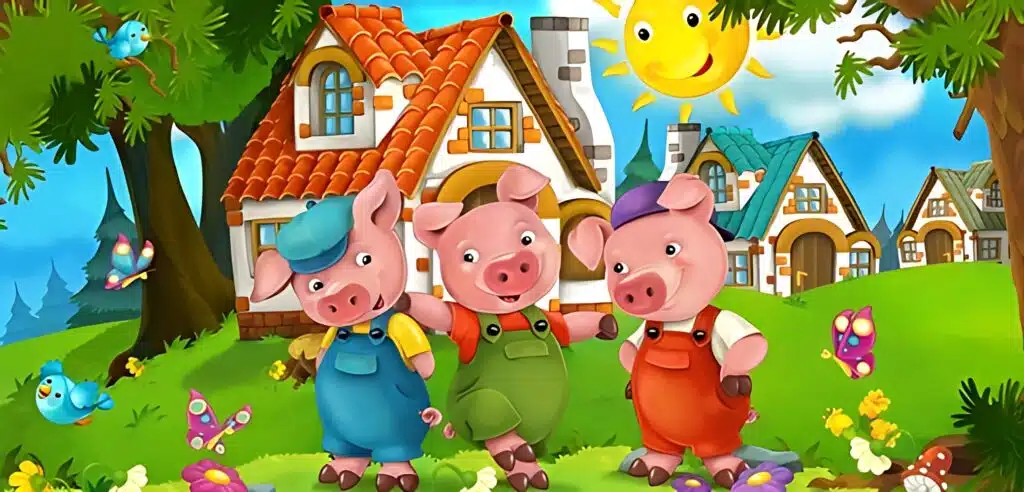
1- Brief of the Story
“The Three Little Pigs” is a classic tale that revolves around three pig siblings, each building their own house with different materials: straw, sticks, and bricks. A big, bad wolf threatens each pig, huffing and puffing to blow their houses down. The first two pigs, who chose weaker materials for ease and speed, find their houses destroyed and must seek refuge with their wiser brother. The third pig, who invested time and effort into a sturdy brick house, provides a safe haven, and the wolf fails to destroy it, ultimately meeting his defeat and teaching a valuable lesson about diligence and foresight.
2- Title Analysis
The title “The Three Little Pigs” is simple, clear, and immediately introduces the main characters of the story. It sets the stage for a narrative that is likely to explore their adventures or misadventures, providing a straightforward and easily recognizable example of story that appeals to children and adults alike, inviting them into a tale of mischief, danger, and clever problem-solving.
3- Analyzing Key Elements and Takeaways
This story, with its clear narrative arcs and moral lesson, serves as a timeless example of story that explores the virtues of hard work, strategic thinking, and the consequences of taking shortcuts. Through the distinct choices and fates of the three pig siblings, the tale effectively communicates its moral messages while providing an engaging and entertaining narrative.
4- Character Names
– The First Little Pig
– The Second Little Pig
– The Third Little Pig
– The Big Bad Wolf
5- Plot Points
– Each pig builds a house with different materials, reflecting their individual attitudes towards work and safety.
– The wolf threatens each pig in turn, testing the strength of their houses.
– The first two pigs’ houses are destroyed due to their use of weak materials and hasty construction.
– The third pig’s sturdy brick house withstands the wolf’s efforts, providing safety and defeating the wolf.
6- Themes of the Story
– Hard Work and Laziness: The contrasting work ethics of the pigs highlight the values of diligence and the pitfalls of laziness.
– Safety and Danger: The persistent threat of the wolf and the varying safety of the houses explore themes of security, foresight, and impending danger.
– Wisdom and Folly: The wise choices of the third pig contrast sharply with the foolishness of his siblings, providing a clear moral distinction.
– Victory and Defeat: The ultimate safety of the third pig and the defeat of the wolf underscore the triumph of wisdom and foresight over malice and threat.
“The Three Little Pigs” remains a cherished tale, serving as an engaging example of a story that blends adventure, danger, moral lessons, and the triumphant victory of wisdom and hard work over folly and malice.
Example 9: “Peter Pan” by James Matthew Barrie
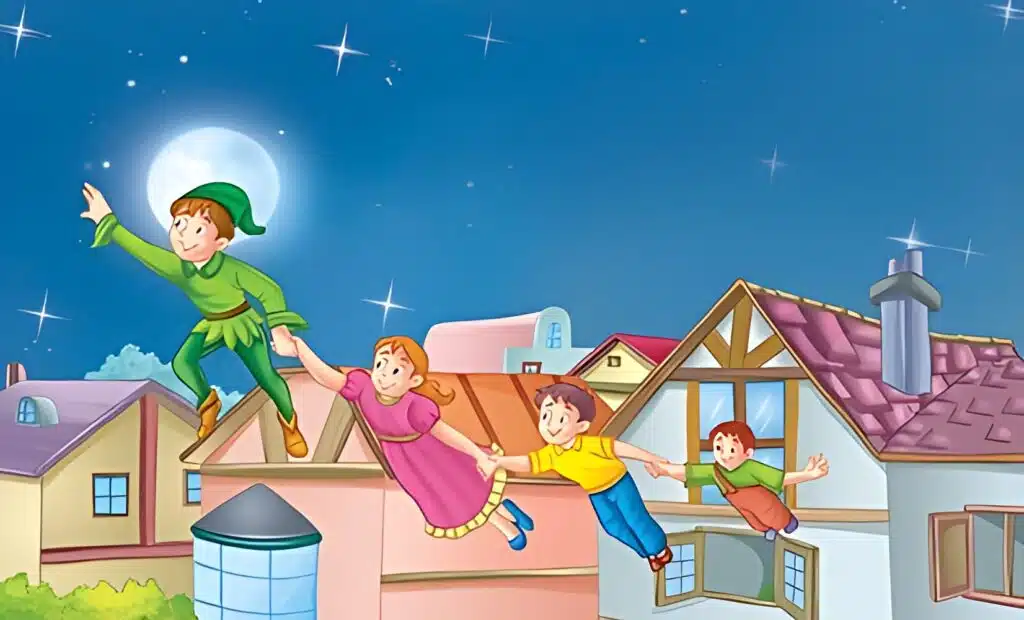
1- Brief of the Story
“Peter Pan” is a whimsical and adventurous tale that introduces readers to a boy who refuses to grow up, exploring the fantastical world of Neverland alongside his fairy sidekick, Tinker Bell. Peter invites Wendy, John, and Michael Darling to join him in his adventures, where they encounter pirates, mermaids, and the indigenous tribe. The notorious Captain Hook, Peter’s arch-enemy, provides a constant threat with his sinister plans. The story intertwines themes of eternal youth, friendship, bravery, and the inevitable transition from childhood to adulthood, offering a bittersweet exploration of the joys and pangs of growing up.
2- Title Analysis
“Peter Pan” is a succinct and enchanting title that immediately identifies the central character around whom the story revolves. The name itself has become emblematic of eternal youth and the fantastical adventures that unfold in the narrative. It’s a title that invites readers into a world where the ordinary rules of time and maturity are suspended, providing a timeless example of story that appeals to the young and the young at heart.
3- Analyzing Key Elements and Takeaways
Barrie crafts a narrative that is as enchanting as it is thought-provoking, providing an example of a story that explores the complexities of youth, freedom, responsibility, and the inexorable march of time. Through the adventures and interactions of Peter and his friends, the story delves into the paradoxes of eternal childhood and the multifaceted journey of growing up.
4- Character Names
– Peter Pan
– Wendy Darling
– John Darling
– Michael Darling
– Captain Hook
– Tinker Bell
5- Plot Points
– Peter invites the Darling children to Neverland, introducing them to a world of adventure and danger.
– Various adventures with the inhabitants of Neverland, including pirates, mermaids, and the tribe.
– The ongoing battle between Peter Pan and Captain Hook, symbolizing the clash between freedom and tyranny.
– Wendy’s eventual decision to return to the real world and embrace the journey of growing up.
6- Themes of the Story
– Youth and Maturity: The story explores the joys and challenges of both eternal youth and the process of maturation.
– Freedom and Responsibility: Through the adventures in Neverland, the narrative explores the balance between unbridled freedom and the acceptance of responsibility.
– Adventure and Danger: The various escapades in Neverland underscore the thrill of adventure and the ever-present shadow of danger and loss.
– Friendship and Loyalty: The bonds formed between Peter, the Darling children, and the inhabitants of Neverland highlight themes of friendship, alliance, and the complexities of loyalty.
“Peter Pan” serves as a rich and multifaceted example of a story that, through its fantastical adventures and poignant themes, continues to captivate, entertain, and provoke thought across generations, exploring the eternal struggle between the desire for perpetual youth and the beautiful, albeit bittersweet, journey towards maturity.
Example 10: “Puss in Boots” by Charles Perrault

1- Brief of the Story
“Puss in Boots” tells the adventurous tale of a clever cat who uses his wit and guile to secure a prosperous future for his lowly-born master. Inherited by the youngest son of a miller, the seemingly ordinary cat requests a pair of boots and sets forth on a remarkable journey. Through a series of clever maneuvers, including convincing a rich king that his master is a nobleman and outsmarting a wicked ogre, Puss elevates his master to wealth and a royal marriage. The story intertwines themes of cleverness, resourcefulness, and the transformative power of audacity and belief.
2- Title Analysis
“Puss in Boots” is a straightforward yet intriguing title that piques curiosity by presenting an animal in an anthropomorphic scenario. The title is both literal, referring to the cat’s notable attire, and symbolic, hinting at the adventurous and transformative journey that lies ahead. It’s an inviting example of a story that promises a blend of adventure, humor, and clever maneuvering, appealing to both children and adults.
3- Analyzing Key Elements and Takeaways
Perrault crafts a narrative that is both entertaining and thought-provoking, providing an example of a story that explores the power of ingenuity, the ability to manipulate social perceptions, and the unexpected potential that may lie in seemingly unremarkable things. Through Puss’s adventures and strategies, the story highlights how cleverness and a bit of audacity can alter one’s destiny.
4- Character Names
– Puss
– The Youngest Son (Master of Puss)
– The King
– The Ogre
– The Princess
5- Plot Points
– The youngest son inherits Puss and provides him with boots, as requested.
– Puss sets forth, creating a fictitious noble identity for his master through clever tricks.
– Puss outsmarts an ogre, securing a castle and wealth for his master.
– The master, now perceived as a nobleman, marries the princess and ascends to prosperity and happiness.
6- Themes of the Story
– Cleverness and Deception: Puss utilizes his wit and engages in deceptive acts to alter his and his master’s fate.
– Rags to Riches: The story exemplifies a dramatic social and financial ascent from lowly beginnings to royal affluence.
– Adventure and Strategy: Puss’s adventures are marked by strategic planning and bold actions, highlighting the thrill of adventure intertwined with tactical thinking.
– Transformation and Perception: The narrative explores how altering perceptions can transform realities and alter destinies.
“Puss in Boots” stands as a vibrant example of a story that, through its adventurous spirit, clever strategies, and unexpected twists, continues to entertain and inspire readers with its timeless themes of ingenuity, transformation, and the boundless possibilities that can arise from believing in the seemingly impossible.
6. Tips and Tricks for Aspiring Short Story Writers
Utilizing Short Story Writing Samples as Inspiration
Embarking on your writing journey can be thrilling yet daunting. One way to navigate through the waves of creativity is to draw inspiration from existing works.
For instance, exploring various examples of short stories and short fiction stories examples can offer a wealth of ideas and insights.
Dive into the worlds crafted by seasoned writers, observe their narrative techniques, character development, and how they weave themes into their tales. Remember, inspiration is not imitation but a springboard for your own unique creations. Analyze, learn, and let these stories fuel your imagination and guide your pen in crafting your own tales.
Balancing Brevity and Depth in Short Stories
The art of short story writing lies in encapsulating expansive ideas within limited words, providing a short story sample that is both concise and profound. Here are a few tips to balance brevity and depth:
– Focus on a Singular Theme: Let one main idea or theme guide your story, ensuring clarity and coherence.
– Limit Characters: Introduce only as many characters as absolutely necessary to avoid diluting the narrative focus.
– Economize Words: Ensure every word, sentence, and paragraph propels the story forward, eliminating unnecessary details.
– Create Strong Openings: Capture attention from the get-go, ensuring readers are hooked from the first sentence.
– Craft Impactful Endings: Leave a lasting impression with endings that resonate, providing closure or provoking thought.
Drawing from the short short stories examples, observe how writers manage to tell compelling stories within a limited word count, providing a rich yet succinct reading experience. It’s a delicate dance between saying enough to convey the story effectively and maintaining the brevity that defines the short story genre. So, as you pen down your stories, weave your tales with intention, ensuring every element serves the narrative, and remember: sometimes, less truly is more.
7. Conclusion
Recap of Explored Short Story Examples
Our journey through the realm of short stories has been nothing short of enchanting. From the mischievous escapades of Peter Rabbit to the timeless lessons of Aesop’s fables, from the whimsical adventures of Peter Pan to the clever machinations of Puss in Boots, we’ve delved deep into a tapestry of tales that span themes, cultures, and emotions.
These stories, whether they’re examples of short story classics or more contemporary short fiction stories examples, serve as a testament to the power of concise storytelling. They capture the essence of human experiences, dreams, fears, and hopes, all within a limited word count.
Each story, be it a short story sample or a more elaborate narrative, offers unique insights into the craft of writing and the endless possibilities it presents.
As we conclude our exploration, it’s evident that the world of short stories is vast, vibrant, and ever-evolving.
Whether you’re a reader seeking solace in these tales or an aspiring writer drawing inspiration, remember that every story, no matter how short, has the power to leave an indelible mark on the heart and mind. Here’s to the magic of storytelling and the endless adventures it promises!